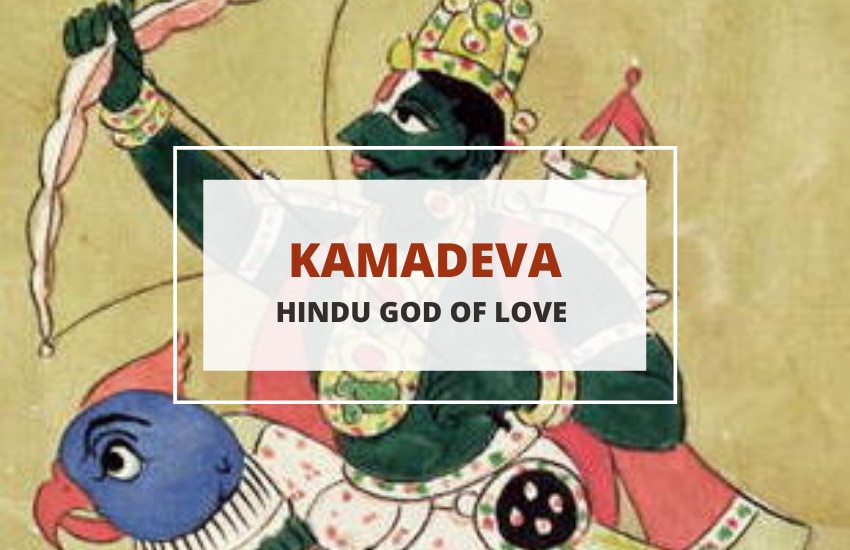
Table of Contents
Cupid-like deities exist in many mythologies, and they are often portrayed with a bow and arrow. Yet few are as colorful and extravagant as Kamadeva – the Hindu god of love and lust. Depicted as a beautiful young man despite his strange green skin, Kamadeva flies on a giant green parrot.
This bizarre appearance is far from the only unique thing about this Hindu deity. So, let’s go over his fascinating story below.
Who is Kamadeva?
If Kamadeva’s name doesn’t sound familiar at first, it’s because he’s often overshadowed by Parvati – the Hindu goddess of love and fertility. Just as in other religions, however, the presence of one (usually female) deity of love and fertility doesn’t negate the presence of others.
On the other hand, if Kamadeva’s name does sound familiar, that’s likely because it’s constructed from the Sanskrit words for god (deva) and sexual desire (kama), as in kama-sutra, the famous Hindu book (sutra) of love (kama).
Other names for Kamadeva include Ratikānta (Lord of Rati his consort), Madana (Intoxicating), Manmatha (One who agitates the heart), Ragavrinta (stalk of passion), Kusumashara (One with arrows of flowers), and a few others we’ll get to below.
Kamadeva’s Appearance
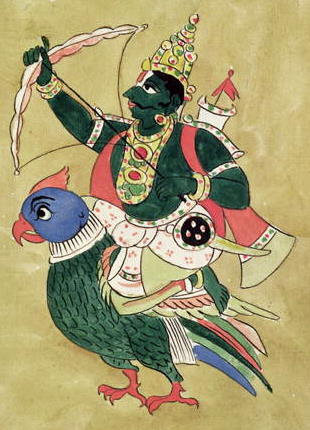
The green, and sometimes reddish, skin of Kamadeva can seem unappealing to people today, but Kamadeva is described as the most beautiful man to have ever existed among both the gods and people. He’s also always adorned in beautiful clothes, typically in the yellow to the red color spectrum. He has a rich crown as well as plenty of jewelry around his neck, wrists, and ankles. He’s sometimes even depicted with golden wings on his back.
Kamadeva is often shown with a curved saber hanging from his hip even though he isn’t a war-like deity and isn’t a fan of using it. The “weapon” he likes to use is a sugarcane bow with a string covered with honey and honeybees, which he uses with arrows of scented flower petals instead of metal points. Like his Western equivalents Cupid and Eros, Kamadeva uses his bow to strike people from a distance and make them fall in love.
The flower petals on Kamadeva’s arrows are not just for style. They come from five different plants, each symbolizing a different sense:
- Blue lotus
- White lotus
- Ashoka tree flowers
- Mango tree flowers
- Jasmine mallika tree flowers
That way, when Kamadeva shoots people with all his arrows at once, he awakens all their senses to love and lust.
Kamadeva’s Green Parrot
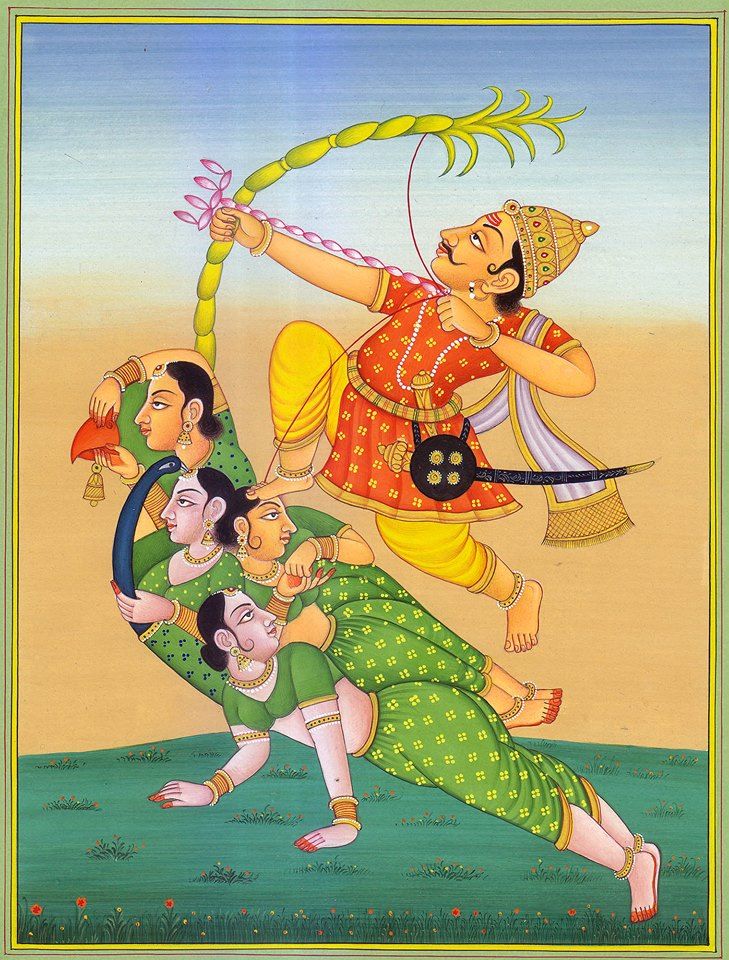
The green parrot Kamadeva rides on is called Suka and he’s Kamadeva’s faithful companion. Suka is often portrayed not as a parrot but as several women in green garments arranged in the shape of a parrot, symbolizing Kamadeva’s sexual prowess. Kamadeva is also often accompanied by Vasanta, the Hindu god of spring.
Kamadeva has a permanent consort too – the goddess of desire and lust Rati. She is sometimes shown with him riding on her own green parrot or is just referred to as the attribute of lust.
Kamadeva’s Origins
A confusing birth
There are several conflicting stories regarding Kamadeva’s birth depending on which Purana (ancient Hindu text) you read. In the Mahabharata Sanskrit epic, he is a son of Dharma, a Prajapati (or god) who himself was born from the Creator god Brahma. In other sources, Kamadeva is himself a son of Brahma. Other texts describe him at the service of the god and king of the heavens Indra.
There is also a view that Kamadeva was the very first thing to come into being when Brahma created the universe. According to the Rig Veda, the earliest of the four Hindu Veda texts:
“In the beginning, darkness was hidden by darkness with no distinguishing sign; all of this was water. The life force that was covered with emptiness arose through the power of heat. Desire (kama) arose in It in the beginning; that was the first seed of the mind. Wise Sages seeking in their hearts, with wisdom, found it to be the bond that connects existence with non-existence.” (Rig Veda 10. 129).
Burned Alive
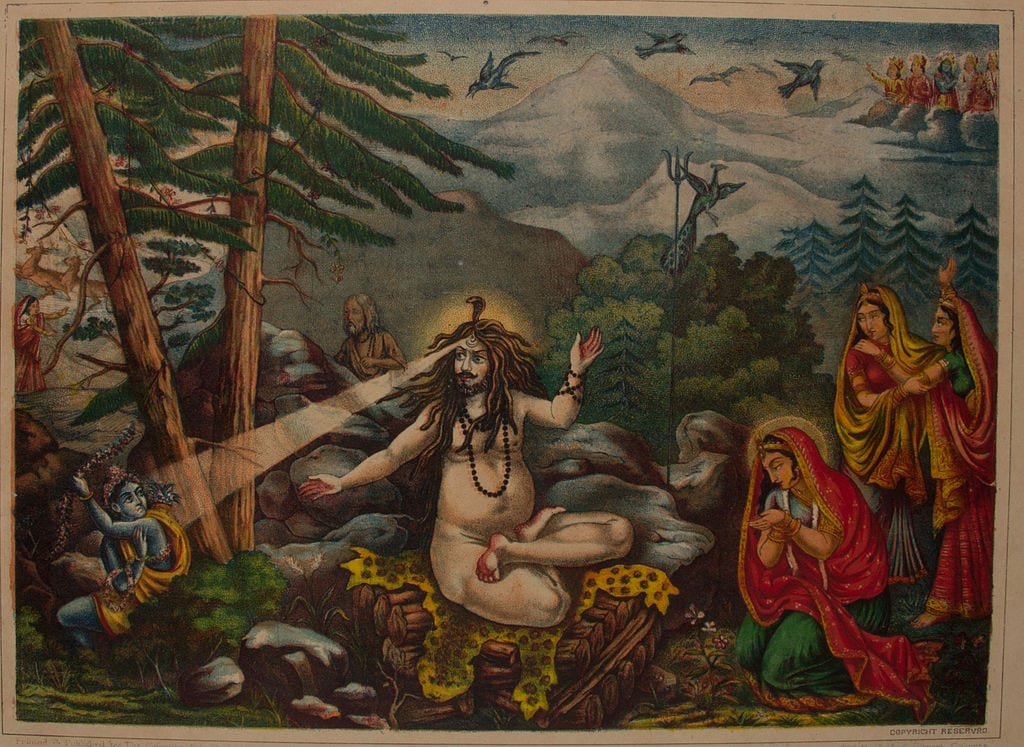
Probably the most famous myth involving Kamadeva is that told in the Matsya Purana (verses 227-255). In it, Indra and many other Hindu gods are tormented by the demon Tarakasura who was said to be undefeatable by anyone other than Shiva’s son.
So, the Creator god Brahma advised Indra that the goddess of love and fertility Parvati should do a pooja with Shiva – a religious ritual of devotional prayer done in Hinduism as well as Buddhism and Jainism. In this case, however, the implication is of a more sexual type of pooja as the two needed a son of Shiva to be born.
Shiva was in deep meditation at the time and wasn’t with the other gods. So, Indra told Kamadeva to go and break Shiva’s meditation and help create a more congenial atmosphere.
To accomplish that, Kamadeva first created akāla-vasanta or an “untimely spring”. Then, he took the form of a fragrant breeze and sneaked past Shiva’s guard Nandin, entering Shiva’s palace. However, upon shooting Shiva with his flowery arrows to make him fall in love with Parvati, Kamadeva also startled and angered the god. Shiva incinerated Kamadeva on the spot using his third eye.
Devastated, Kamadeva’s consort Rati pleaded with Shiva to bring Kamadeva back to life and explained that his intentions had been good. Parvati also consulted Shiva about it and the two revive the god of love from the pile of ash he was now reduced to.
Shiva did have one condition, however, and it was that Kamadeva remained incorporeal. He was alive once again, but did not have a physical self anymore and only Rati was able to see or interact with him. That’s why some of Kamadeva’s other names are Atanu (One without body) and Ananga (Incorporeal).
From that day on, Kamadeva’s spirit was left disseminated to fill the universe and always affect humanity with love and lust.
A Possible Rebirth
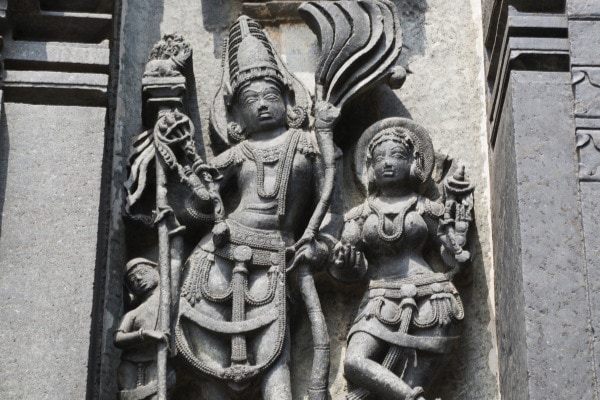
In another version of the myth of Kamadeva’s incineration told in the Skanda Purana, he isn’t revived as an incorporeal ghost but is reborn as Pradyumna, the eldest son of the gods Krishna and Rukmini. However, the demon Sambara knew of a prophecy that the son of Krishna and Rukmini would one day be his destroyer. So, when Kama-Pradyumna was born, Sambara kidnapped him and threw him in the ocean.
There, the baby was eaten by a fish and that same fish was then caught by fishermen and brought to Sambara. As fate would have it, Rati – now under the name of Mayavati – was disguised as Sambara’s kitchen maid (Maya meaning “mistress of illusion”). She was in this position after she had angered the divine sage Narada and he had provoked the demon Sambara to kidnap her as well.
Once Rati-Mayavati cut open the fish and discovered the baby inside, she decided to nurture it and raise it as her own, unaware that the baby was her reborn husband. The sage Narada decided to offer help, however, and informed Mayavati that this was indeed Kamadeva reborn.
So, the goddess helped raise Pradyumna into adulthood by becoming his nanny. Rati also acted as his lover once again even while she was still his nanny. Pradyumna was hesitant at first as he saw her as a mother figure but after Mayavati told him about their common past as lovers, he agreed.
Later, after Kama-Pradyumna matured and killed Sambara, the two lovers returned to Dwarka, Krishna’s capital, and got married once again.
Symbolism of Kamadeva
Kamadeva’s symbolism is very similar to that of other gods of love we know of. He’s an incarnation of love, lust, and desire, and he flies around shooting unsuspecting people with arrows of love. The “shooting” part likely refers to the feeling of falling in love and how sudden it often is.
The Rig Veda text about Kama (passion) being the first thing to emerge from the nothingness of space is also quite intuitive as it’s love and passion that creates life.
In Conclusion
Kamadeva is quite a colorful and extravagant deity that flies on a green parrot and shoots people with flowery arrows of love. He is often associated with other similar celestial archers such as the Roman Cupid or the Greek Eros. However, as one of the first Hindu deities, Kamadeva is older than either of them. This only makes his fascinating story – from being the first of all creation to then being incinerated and dispersed across the universe – all the more unique and interesting.








